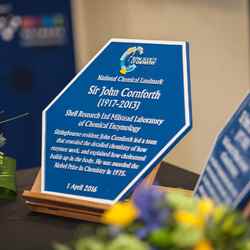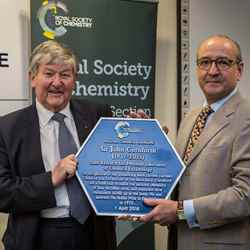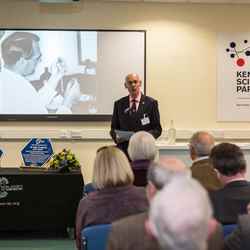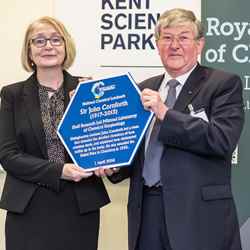Twin Chemical Landmark plaques unveiled in Sittingbourne
Kent Science Park and Sittingbourne Town Library are now home to two new blue plaques celebrating the life and chemistry research of Nobel Prize-winning scientist Sir John Cornforth.
Our Chemical Landmark Scheme recognises sites where the chemical sciences have made a significant contribution to health, wealth, or quality of life. The distinctive blue plaques are publicly visible, giving everyone an insight into chemistry's relevance to our lives.
Unveiling the plaque at Kent Science Park, past president of the Royal Society of Chemistry, Professor David Phillips, said: “It is my great pleasure to present this Chemical Landmark to commemorate Sir John Cornforth’s pioneering work as co-director of Shell’s Milstead Laboratory of Chemical Enzymology, here in Kent Science Park.
“Cornforth made many significant contributions to science and to society. During World War Two, he was part of the group that worked on stabilising and purifying the drug penicillin, and in 1975 he was joint winner of the Nobel Prize in chemistry for his research on the stereochemistry of enzyme-catalysed reactions.
“Cornforth and his Milstead colleagues helped to show how cholesterol was made in living tissues. Their work eventually led to the development of statins, which are used to control cholesterol levels in humans, lowering the risk of heart disease.
“It is a particular pleasure to present this plaque in the year that we celebrate the 175th anniversary of the Royal Society of Chemistry”.
Stephen Moore, Facilities Manager at Kent Science Park, said: “It is an honour to receive this recognition at Kent Science Park. Shell Research was the start of something very special here in Kent; which Kent Science Park continues to build on by providing a centre of excellence for innovation and research.
“We hope the plaque continues to recognise the work carried out by Sir John Cornforth and encourages the budding scientists of today to follow their dreams”.
The Chemical Landmark scheme was created fifteen years ago, to bring to life the history of chemistry. There are now more than fifty blue plaques around the UK and four international ones, highlighting places linked to an important advance in science.
Sir John Cornforth is a particularly inspiring example. Not only did he make a significant contribution to science and society. But he also overcame the challenge of profound deafness.
He was ten when he started to lose his hearing and, by the time he was an undergraduate, he was unable to hear the lecturers. Learning through reading and practical work, Cornforth graduated with first class honours. He also had the support of his wife Rita, a gifted chemist who collaborated with him throughout their lives.
Throughout his career, Cornforth never let his deafness prevent him from fulfilling his potential. That’s why has was chosen as one of the 175 Faces of chemistry, to celebrate diversity in science, and inspire the next generation of chemists.
We are grateful to Kent County Council and Sittingbourne Library for giving us permission to install the two plaques.
Members of the Royal Society of Chemistry’s Kent Local Section were instrumental in organising the events, including a number who used to work in the Milstead Laboratory.
Press office
- Tel:
- +44 (0) 20 7440 3351
- Email:
- Send us an email





